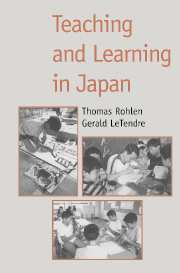Book contents
- Frontmatter
- Contents
- List of contributors
- Introduction: Japanese theories of learning
- Section I Fundamental approaches
- Teaching and learning in the Rinzai Zen monastery
- Building character
- Section II The emotional foundations of early learning
- Section III School and classroom models
- Section IV Path and guidance
- Section V Artistic pursuits – old and new
- Conclusion: themes in the Japanese culture of learning
- References
- Index
Building character
Published online by Cambridge University Press: 05 June 2012
- Frontmatter
- Contents
- List of contributors
- Introduction: Japanese theories of learning
- Section I Fundamental approaches
- Teaching and learning in the Rinzai Zen monastery
- Building character
- Section II The emotional foundations of early learning
- Section III School and classroom models
- Section IV Path and guidance
- Section V Artistic pursuits – old and new
- Conclusion: themes in the Japanese culture of learning
- References
- Index
Summary
Basic categories of human development are not necessarily sorted out the same way in every society. A case in point is what Japanese call “spiritual training” (seishin kyōiku), a range of experience based on forms of instruction that entail a mixture of physical ordeals, lessons in social morality, and character building.
The basic logic is that to grow spiritually, to mature, and to gain character strength, one must suffer one or another kind of hardship. Creating instructive hardships or challenges to mind and body (here, a false dichotomy) is the foundation of the teaching enterprise. Certainly, the degree of difficulty to be endured and the size of the challenge to be overcome are not without limits. Thus, the techniques involved have as much to do with calibrating the right amount of hardships as with explaining them in a manner that links the experience to understanding. We find this kind of learning to be common in such places as Outward Bound, military training, sports, summer camps and the like. The Japanese approach is eclectic, inclusive, and expansive. Because there is much Japanese interest in the possibilities, there is much creativity and variation. Americans locate these activities on the private side of the publicprivate ledger because they involve personal growth and because they are painful to some degree – things we see as matters of personal choice and voluntary submission to a particular training regimen.
- Type
- Chapter
- Information
- Teaching and Learning in Japan , pp. 50 - 74Publisher: Cambridge University PressPrint publication year: 1996
- 12
- Cited by

